Physical Address
304 North Cardinal St.
Dorchester Center, MA 02124
The most common causes of mandibular defects requiring reconstruction are malignancy, benign tumors, trauma, infection, and osteoradionecrosis.
The goals of mandibular reconstruction are to (1) maintain oral competency, (2) maintain occlusal relationships of remaining teeth, (3) maintain the temporomandibular joint alignment and architecture, (4) maintain contour of lower third of the face, (5) and allow for dental rehabilitation.
The gold standard for significant mandibular defects is vascularized free tissue transfer with rigid fixation.
The patient's preoperative oral function, size and location of surgical defect, pathology, potential need for adjuvant therapy, and overall goals are essential in planning for a functional mandibular reconstruction.
Reconstruction of the soft tissue components associated with mandibular defects is critical in restoring oral function.
Modern technologies, including virtual surgical planning, additive manufacturing, and custom plating technologies have emerged to allow more precise and personalized reconstruction options.
Mandibular reconstruction is a challenging functional dilemma; however, through understanding the form and function of the mandible and current reconstructive techniques, near-normal oral function can be restored.
The importance of the mandible as the gateway to the upper aerodigestive tract makes the functional rehabilitation of this structure paramount in complex head and neck reconstruction. Throughout the 19th and majority of the 20th century, mandibular reconstruction was limited, and generally patients who suffered from the loss of the mandible were oral cripples, unable to eat, swallow, talk, and breathe in a natural manner. Through the introduction of rigid plating technologies and free vascularized tissue transfer, the mandible can now be adequately restored to allow most patients these basic functions. Panje et al. first published on free tissue transfer for mandibular reconstruction using the iliac crest bone in 1981, followed by Hidalgo et al., who published the first mandibular reconstruction using the fibula free flap in 1989. Many advances have come since that time and free tissue transfer has become the gold standard in mandibular reconstruction. However, there are still many limitations with current techniques, including difficulties with dental rehabilitation, complications arising from implantable plates and screws, donor site complications, and prolonged operative times. Although tissue-engineering techniques are being developed to regrow bone, the current state of the art does not provide results comparable to those of free tissue transfer. This chapter will cover the current state of the art of mandibular reconstruction and introduce technologies aiming to overcome current shortcomings in mandibular reconstruction.
The mandible is the strongest and largest bone of the face with many important functions that must be considered for functional reconstruction of the lower face. The principal function of the mandible is to support and align the lower teeth to allow for mastication with precise dental occlusion. The mandible also supports the muscles of the tongue and floor of mouth, suspending the hyoid bone in the mid neck. From the hyoid, the larynx is also suspended, thus making the mandible an important framework for both the tongue and the larynx for both swallowing and speech. The mandible also supports the lower lip, providing a stable base for the lip, allowing for oral competency. Furthermore, the mandible supports the upper airway by preventing posterior collapse of the oral tongue and oropharynx. Finally, the mandible is an important cosmetic unit of the face and the mandibular height, contour, and projection should be considered during mandibular reconstruction.
The mandible consists of a strong horizontal bony arch anteriorly, with the midline symphysis, and parasymphyseal and body regions bilaterally. This provides the inferiormost horizontal or transverse buttress of the facial skeleton. Posteriorly, there are bilateral vertical segments consisting of the rami, terminating in the coronoid process anteriorly and condylar process posteriorly ( Fig. 92.1 ). These rami form the inferior-most vertical buttresses of the facial skeleton. The coronoid process serves as an insertion for the temporalis muscle tendon. The condyle articulates with the temporal bone in the condylar fossa via a synovial sliding-ginglymoid joint. The articular surfaces are lined with fibrocartilage rather than hyaline cartilage as in other joints in the body. There is an articular disk between the condyle and the condylar fossae that cushions the surfaces and allows for the complex sliding and hinge movements of the mandible. In cross section, the mandible consists of medial (lingual) and lateral (buccal) dense cortical bone, surrounding a core of cancellous bone containing bone marrow, nerves, blood vessels, and lymphatics. The typical mandible allows for an average maximal mouth opening of approximately 40 to 50 mm, taking into account sex and body habitus. The mandible also allows for about 10 mm of protrusion, 5 mm of retrusion, and lateral shifting of 10 mm to either side. Despite this three-dimensional mobility, the intact mandible closes effortlessly into precise dental occlusion.
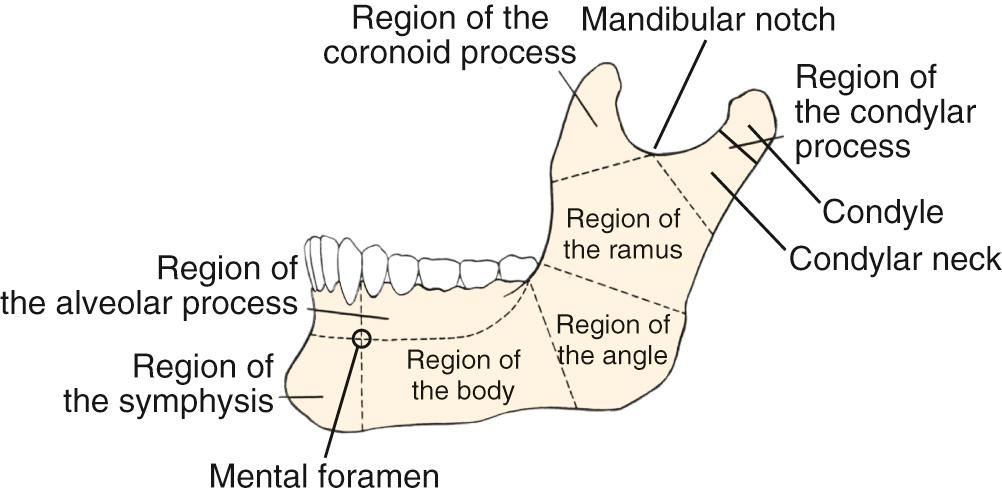
The muscles of mastication—the temporalis, masseter, medial pterygoid, and lateral pterygoid muscles—produce mandibular movements. The anterior belly of the digastric, geniohyoid, mylohyoid, buccinator, and infrahyoid strap muscles (through their influence on the hyoid bone) serve as accessory muscles of mastication. Understanding the influence of each of these muscles on the mandible is essential to understand the effect of releasing these muscles from the mandible and disruption of the mandibular arch as outlined in Table 92.1 . Perhaps the most important relationship is that of the medial pterygoid and masseter, forming together the masseteric-pterygoid sling. The masseter and medial pterygoid both work together to close the mouth; however, the masseter pulls on the lateral surface of the mandible and the pterygoid on the medial surface of the mandible. In defects disrupting the mandibular arch, the angle of action of the medial pterygoid allows the pterygoid to overpower the masseter, causing medialization of the angle of the mandible.
| Muscle | Origin | Insertion | Nerve | Function |
|---|---|---|---|---|
| Masseter | Zygomatic arch and maxillary process of zygoma | Lateral surface of the ramus of mandible from the angle to the coronoid process | Masseteric nerve (V3) | Elevation and protrusion of mandible |
| Temporalis | Temporal line of parietal bone and superior temporal surface of the sphenoid bone | Coronoid process of mandible | Deep temporal nerves (V3) | Elevation and retraction of the mandible |
| Medial pterygoid | Medial aspect of lateral pterygoid pate, pyramidal process of palatine bone and maxillary tuberosity | Medial surface of the angle of the mandible | Nerve to medial pterygoid (V3) | Elevation, protrusion and lateral movements of the mandible |
| Lateral pterygoid | Infratemporal fossa and lateral aspect of lateral pterygoid plate | Medial condylar neck | Nerve to lateral pterygoid (V3) | Depression, protrusion, and lateral movements of the mandible |
| Anterior digastric | Digastric fossae of mandible | Hyoid bone | Nerve to mylohyoid (V3) via inferior alveolar nerve | Depression of mandible |
| Geniohyoid | Mental spine of mandible | Hyoid bone | C1 via CNXII (ansa cervicalis) | Depression of mandible |
| Mylohyoid | Mylohyoid line of mandible | Hyoid bone | Nerve to mylohyoid (V3) via inferior alveolar nerve | Depression of mandible |
| Buccinator | Alveolar processes of maxilla and mandible | Orbicularis oris | Buccal branch of CNVII | Elevation of mandible |
| Infrahyoid strap muscles | Manubrium of sternum, scapula, thyroid cartilage | Hyoid bone | Ansa cervicalis (C1-C3) | Depression of mandible |
Along the superior portion of the anterior mandible lies the alveolar process. This bony ridge supports the mandibular dentition. Below the dentition runs the inferior alveolar nerve in the mandibular canal. This canal begins on the medial aspect of the mandibular ramus, just posterior to the bony lingula at the mandibular foramen. The nerve then curves anteriorly below the mandibular dentition, traveling along the trajectory of the mylohyoid line, until it reaches the mental foramen. The mental foramen is typically located near the interspace of the first and second premolar and is usually midway between the upper and lower border of the mandible. Here the nerve enters the mental soft tissue as the mental nerve to provide sensation to the parasymphyseal dentition, gingiva, and lower lip. In the edentulous mandible, the alveolar process that supports the teeth recedes, decreasing the overall vertical height of the mandible and placing the mental foramen close to the gingival surface ( Fig. 92.2 ). Understanding the course of this nerve allows one to preserve its function when possible during mandibular resection and reconstruction.
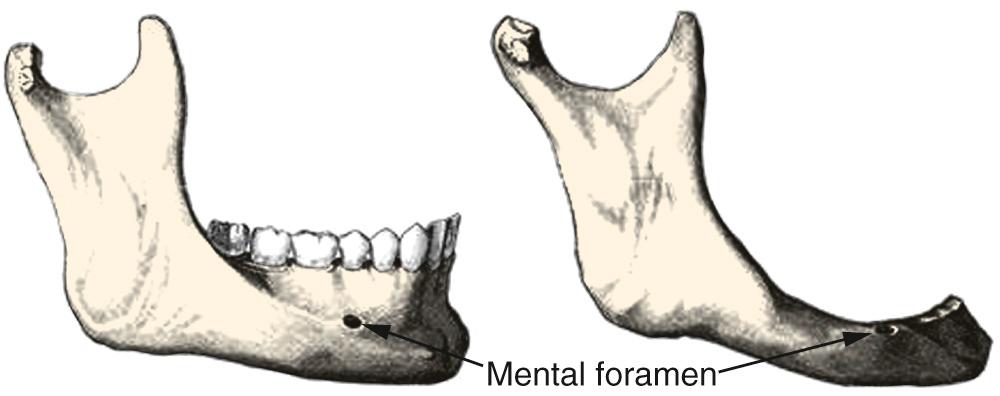
The mandible provides major structural support for the lower face and upper aerodigestive tract, as described in the preceding section. When faced with reconstruction of a mandibular defect, the surgeon must consider the functional consequences of each unique defect. The overall goals of mandibular reconstruction are to (1) maintain oral competency, (2) maintain occlusal relationships of remaining teeth, (3) maintain the temporomandibular joint alignment and architecture, (4) maintain the contour of lower third of the face, and (5) allow for dental rehabilitation. Depending on the size and location of the defect, the nature of the pathology, the condition of dentition, the goals of the patient, and the overall health of the patient, the reconstructive surgeon should be able to determine a method for successful reconstruction.
There are two basic types of mandibulectomies: marginal and segmental ( Fig. 92.3 ). Marginal mandibulectomies leave the mandibular arch intact. To prevent fracture of the mandible, it is generally recommended that a height of at least 1 cm of bone should be left intact at the lower border of the mandible and the osteotomy should be created in a curvilinear fashion. The appropriateness of marginal mandibulectomy has been questioned in oncologic resections. However, marginal mandibulectomy in the setting of periosteal invasion only or limited cortical invasion without marrow space invasion appears to be oncologically equivalent to segmental resection. Reconstruction of marginal defects is generally achieved by soft tissue reconstruction alone either with a soft tissue flap or skin graft. Some authors have recommended placement of a reconstruction plate spanning the segmental bone resection to reinforce the region of the defect. The main disadvantage of this maneuver is the phenomenon of stress shielding, whereby the bone that no longer is experiencing normal loading forces can weaken, as loading forces are a stimulus needed for maintaining bone density. This can increase the load on the plate and cause plate and bone fracture over time. If there is a concern about the strength of the remaining bone, plating is not recommended and a segmental resection should be considered.
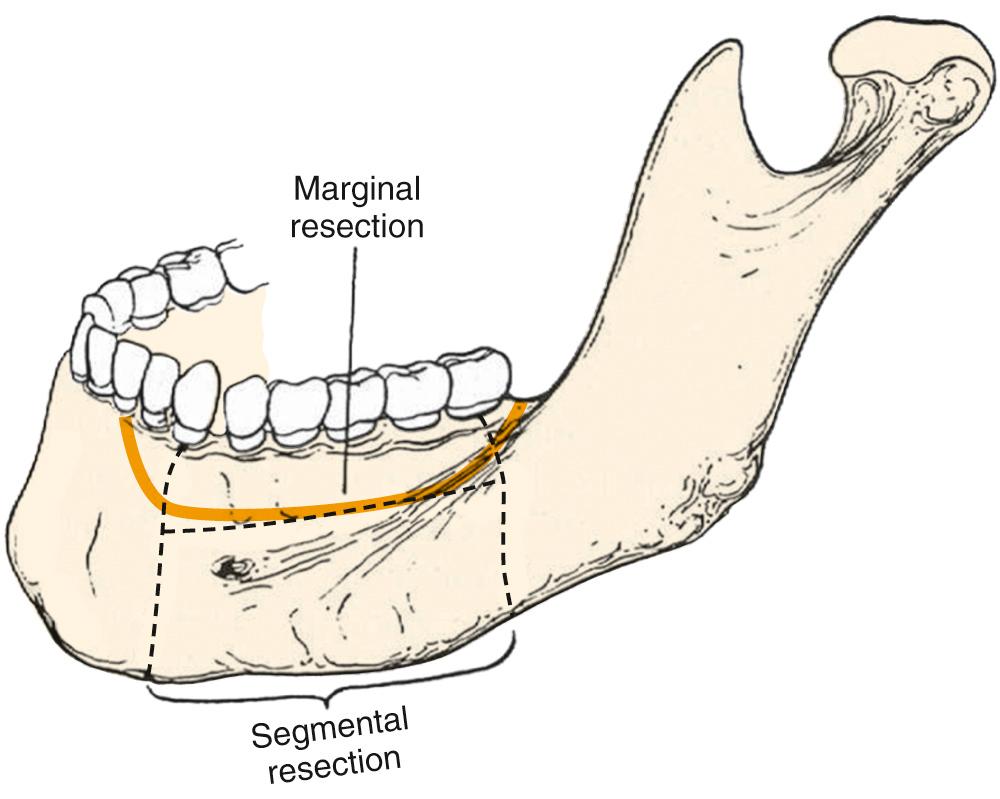
Segmental defects involve the entire height of the mandibular bone. The reconstructive options for these defects become more limited, as the resection proceeds more anteriorly. Defects of the ramus can be successfully rehabilitated with soft tissue only, plate and soft tissue, or bone containing free tissue transfer. Defects incorporating the body of the mandible generally require hard tissue reconstruction in the form of a plate or bone, while anterior defects need bone containing free tissue transfer to maintain a durable reconstruction. Segmental defects involving bone only are generally the consequence of benign mandibular cysts and tumors, trauma, osteomyelitis, and osteoradionecrosis of the mandible. Occasionally, gingival malignancies with limited mucosal disease can invade deeply into the mandibular bone, requiring segmental mandibulectomy while allowing primary closure of the oral cavity mucosa.
Composite defects, including mandibular bone along with gingival, buccal, labial, lingual, floor of mouth, and/or external facial tissue, are common in oral cavity malignancies. Successful reconstruction in these cases requires bone and soft tissue replacement. Through-and-through oral cavity defects are particularly challenging, requiring both internal and external soft tissue to cover the bony reconstruction. Multiple flaps or chimeric flaps (multiple flaps connected via one vascular pedicle, as afforded by the subscapular arterial system) may be required to achieve success in these cases. Goals of associated soft tissue reconstruction include maintaining the position, shape, bulk, and mobility of the tongue and restoration of the buccal soft tissues.
The benefits of reconstruction should be weighed against the unique factors in each individual patient and the patient's current functional status and goals. For example, a patient with osteoradionecrosis of the jaw who is already completely gastrostomy tube dependent due to effects from prior therapy to the pharynx may have little benefit to having a bony reconstruction of the mandible. The goal of therapy in this patient may best be focused on prevention of continued infection, improved pain, maintenance of oral competency, and repair of orocutaneous fistula. Small to moderate lateral defects of the mandible (<5 cm) can be reconstructed with either soft tissue alone or a plate and soft tissue, with good functional and cosmetic results in some cases, especially in edentulous patients.
When bony reconstruction or plating is not employed, the remaining mandible shifts toward the deficient side, and this alters the alignment of the temporomandibular joint, altering the facial contour and disturbing occlusion ( Fig. 92.4 ). However, many patients will continue to function, eat a soft diet, and have an acceptable outcome with such a reconstruction. Reconstruction of the soft tissue only, with either a pedicled or free flap, can provide acceptable flexibility to the tongue and buccal tissues while closing lateral and posterior oral cavity defects.
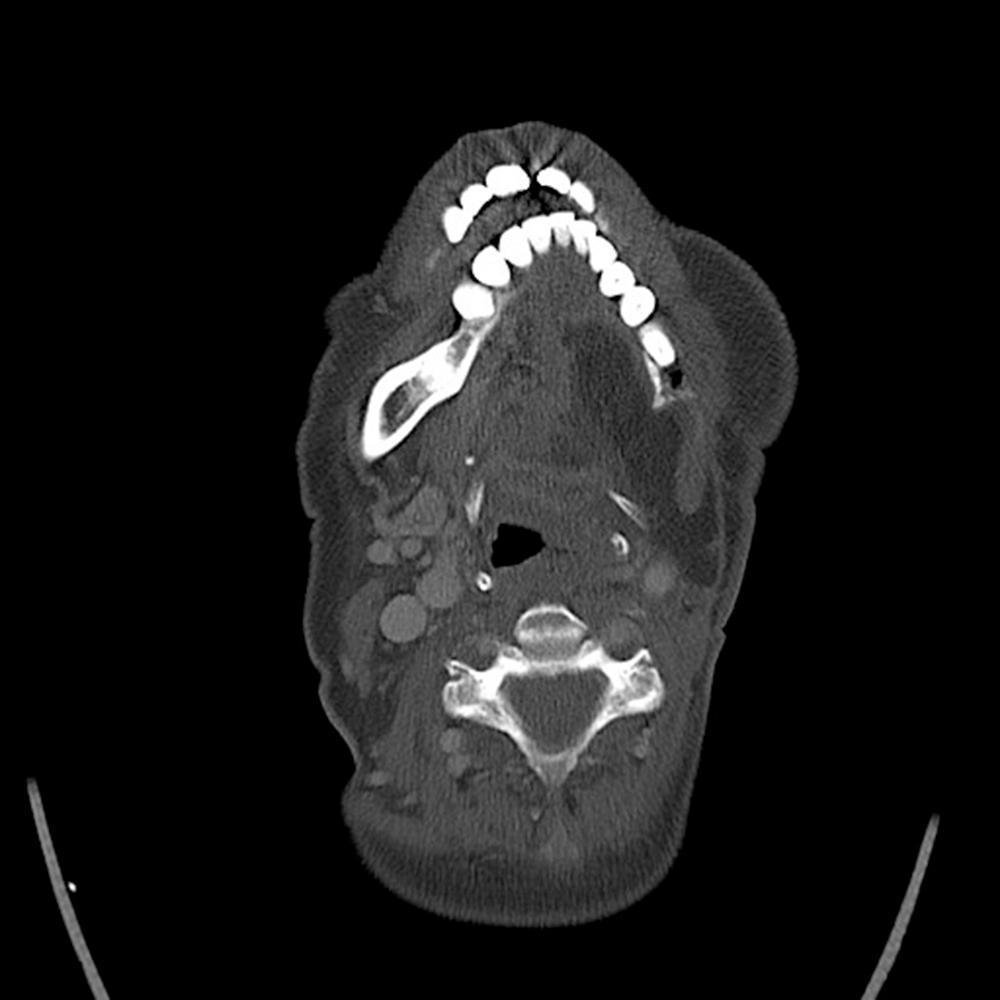
Another viable option for mandibular reconstruction in patients with significant surgical risk, or lack of adequate donor sites, is to rely on a reconstructive plate without any associated attempt at bony reconstruction ( Fig. 92.5 ). Again, this is best suited for short, lateral, and posterior defects where the stress on the plate is limited. Patients should be restricted to a soft diet to prevent loosening or fracture of the plate. Dentulous patients are at increased risk of plate fracture. These plates are also at risk of exposure, so the plate must be adequately covered with soft tissue to prevent plate exposure, either with local soft tissues, pedicled flaps, or free flaps. There are conflicting reports on the effects of postoperative radiation on hardware exposure, loosening, and fracture.
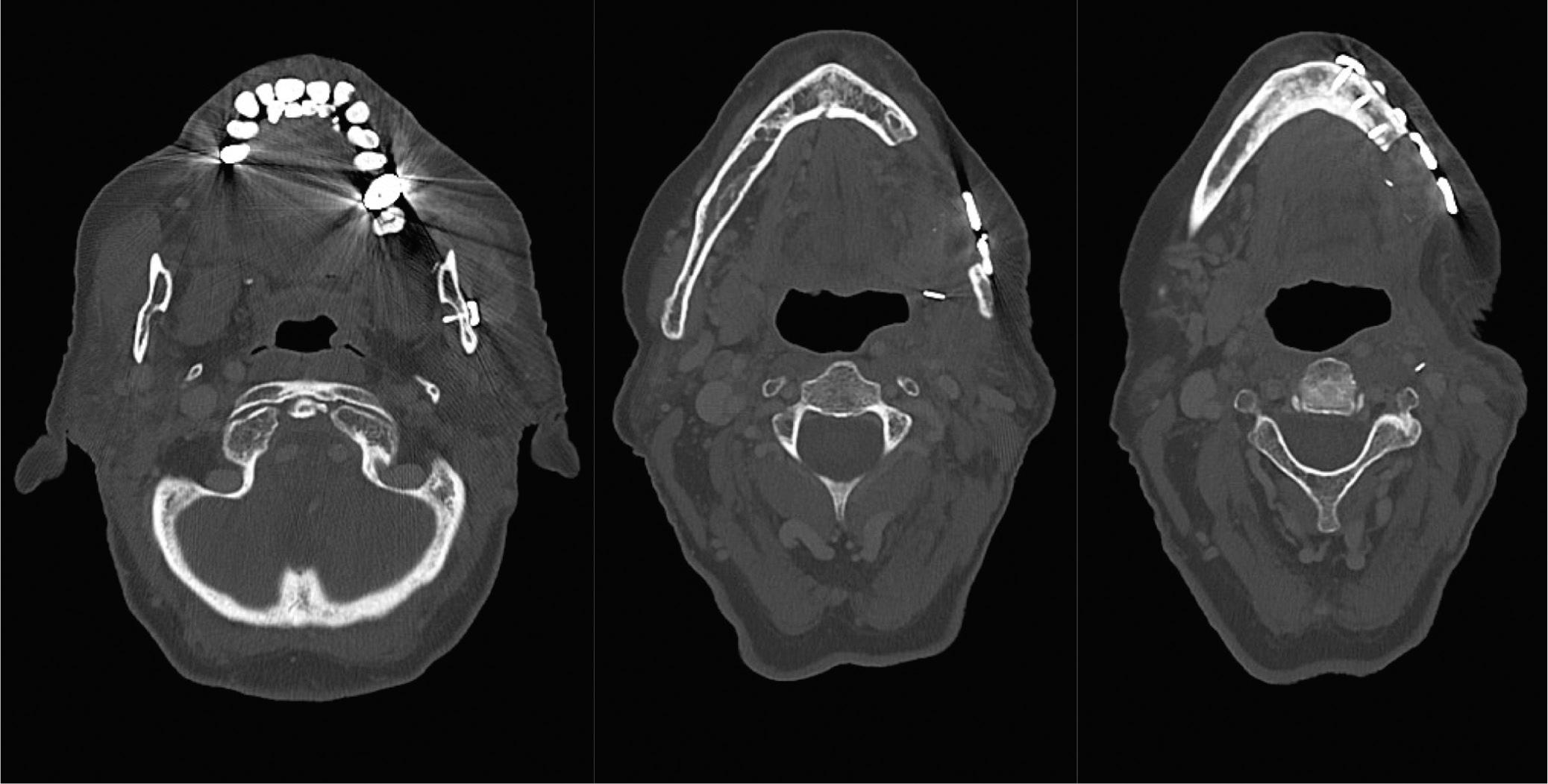
Benign mandibular lesions and traumatic defects allow for consideration of free nonvascularized bone grafting, allografting, and the use of recombinant human bone morphogenetic protein (rhBMP). Crushed or aspirated allograft or autograft bone chips in titanium mesh cribs can provide a substrate for new bone growth in these patients ( Fig. 92.6 ). If a patient is likely to receive radiation therapy following reconstruction, free autograft or allograft bone will not provide a stable bony reconstruction in the time frame prior to receiving this treatment. Furthermore, the use of growth factors in patients with a history of malignancy is dubious, as current understanding of the effects of these proteins on tumorigenesis and metastasis is incomplete.
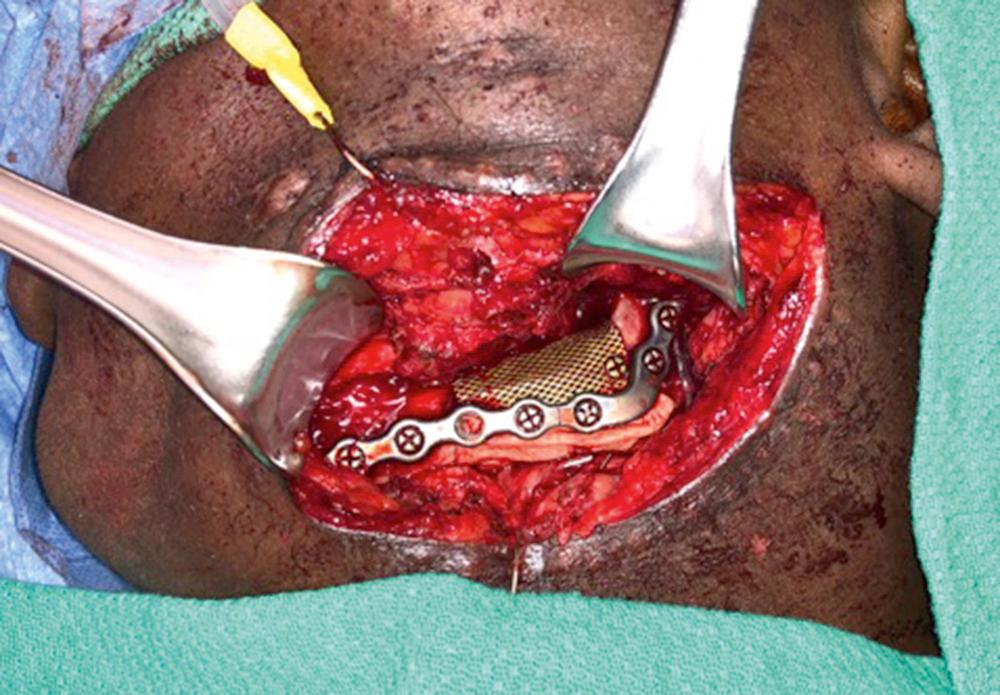
A special mention should be made of reconstruction of the temporomandibular joint. The joint is very complex and bears a considerable amount of compressive and shearing forces with mastication. There are various methods used for reconstruction of the joint, all with varying degrees of success. The simplest method is to place a rounded end of the fibula free flap against the condylar fossa of the temporal bone and use anchoring sutures to hold this vertical segment of bone in position. As the patient heals, this generally will scar into place and provide adequate mouth opening. Other methods include removing the condyle from the resection if possible, and plating this as a free graft to the blunt end of a fibular flap. These free condylar transfers have been shown to be successful in restoring tandem temporomandibular joint function. If the condyle cannot safely be preserved from an oncologic standpoint, a rib cartilage graft can be utilized and secured to the fibular flap as a load-bearing surface. There are also various mechanical prosthetic joints, both condylar head components and condylar fossae components, which can be utilized based on surgeon experience and preference. With the advances of custom plate manufacturing, condylar components can also be manufactured onto a reconstruction plate that is custom to the patient. Complications of loosening, fracture, and wear-through (to the point of violation of the skull base) of these prostheses have been reported, so this remains a controversial topic in mandibular reconstruction.
Free flap reconstruction of the mandible allows the surgeon to bring healthy, vascularized tissue into a defect and is now considered the gold standard in most situations. The most commonly utilized bony free flap donor sites include the fibula, iliac crest, scapula, and radial forearm. Table 92.2 compares the characteristics of these common donor sites.
| Fibula | Iliac Crest | Lateral Border Scapula | Scapula Tip | Radius | |
|---|---|---|---|---|---|
| Ease of harvest | ++ | +/− | − | + | + |
| Bone characteristics | 20–25 cm length Bicortical Thick Short (1.5 cm) |
10–15 cm Tall/thick |
10–12 cm length Short/thin |
9 cm length Ideal shape for angle defects |
Max. 10 cm length Very thin Blood supply is tenuous |
| Soft tissue characteristics | Thin, pliable skin paddle with large surface area Some difficulty with orientation changes in relation to bone Reliability usually good |
Thin board muscle Thick skin relatively fixated to bone |
Thicker skin paddle independent from bone Independent skin paddles possible Possible for “megaflap” when combined with latissimus dorsi flap |
Usually muscle harvested that remucosalizes (latissimus dorsi, teres major, or serratus anterior) Possible for “megaflap” when combined with latissimus dorsi flap |
Thin pliable skin paddle with larger surface area Fixed to orientation of bone |
| Donor-site morbidity | Favorable | Unfavorable (hernias, chronic pain) | Variable (shoulder function) | Overall low and likely better than lateral border scapula flap (shoulder function) | Favorable (plate can be used to prevent radial bone fractures) |
| Dental restoration | + | ++ | +/− | +/− | − |
| Ease of harvest | ++ | +/− | − | + | + |
| Bone characteristics | 20–25 cm length Bicortical Thick Short (1.5 cm) |
10–15 cm Tall/thick |
10–12 cm length Short/thin |
9 cm length Ideal shape for angle defects |
Max. 10 cm length Very thin Blood supply is tenuous |
| Soft tissue characteristics | Thin, pliable skin paddle with large surface area Some difficulty with orientation changes in relation to bone Reliability usually good |
Thin board muscle Thick skin relatively fixated to bone |
Thicker skin paddle independent from bone Independent skin paddles possible Possible for “megaflap” when combined with latissimus dorsi flap |
Usually muscle harvested that remucosalizes (latissimus dorsi, teres major, or serratus anterior) Possible for “megaflap” when combined with latissimus dorsi flap |
Thin pliable skin paddle with larger surface area Fixed to orientation of bone |
| Donor-site morbidity | Favorable | Unfavorable (hernias, chronic pain) | Variable (shoulder function) | Overall low and likely better than lateral border scapula flap (shoulder function) | Favorable (plate can be used to prevent radial bone fractures) |
| Dental restoration | + | ++ | +/− | +/− | − |
The iliac crest flap was once relied on heavily for reconstruction of bony defects, and this flap provides robust bone; however, the donor site is painful, there is a risk of hernia, the amount and length of bone is limited, the pedicle length is short, and the associated soft tissue is limited and often very thick.
The scapular free flap is also adequate for mandibular reconstruction in some instances; however, the bone of the scapular flap is thin and limited in length. Generally, this bone is not adequate to support dental implants. Despite this, the benefit of the scapular free flap is that large and multiple islands of soft tissue can be harvested, and these islands are separated on branches of the subscapular artery, allowing flexibility of the tissues for complex defects, especially defects involving internal lining of the oral cavity, bone, and external skin of the face or neck. Multiple flaps based on a single pedicle are referred to as chimeric flaps. Bony components that are available from the subscapular include the lateral scapular bone, scapular tip, latissimus dorsi, and serratus rib components. Soft tissue components include skin flaps based on the transverse scapular branch of the circumflex scapular artery and the descending parascapular branch of the circumflex scapular artery, as well as the latissimus dorsi muscle and its overlying skin. Furthermore, the subscapular system is often spared of any significant atherosclerotic vascular disease. Therefore, if a patient has peripheral vascular disease limiting the use of the lower extremities, the subscapular system is an excellent alternative.
The radial forearm flap can also be harvested with a segment of the distal radius bone. Only about 40% of the radius diameter can be harvested without compromising the integrity of the distal forearm. The amount of bone stock, both the thickness and length of bone, that can be harvested is quite meager and does not support dental implants. Generally, when this bone is harvested, the forearm is plated to prevent fracture. The addition of a plate in the donor site leads to possible implant-related complications, such as hardware exposure, hardware failure, and infection, that are not present in the other donor sites.
The fibular free flap has become the workhorse of mandibular reconstruction. The abundant bone stock, availability of a moderate amount of associated soft tissue, and adequate vascular pedicle length allow for the reconstruction of complicated, large, and multilayer defects. There is enough bone to reconstruct the entire mandible and this bone is of adequate strength to accept implants for dental reconstruction. Harvest of the bone only allows for tension-free closure of the donor site, and harvest of small skin paddles often allows for primary closure. Large skin paddles, over 2 to 3 cm in width, generally require a split-thickness skin graft for closure, depending on the body habitus of the patient. The skin paddle can be split into multiple segments based on the septocutaneous or musculocutaneous perforators entering the lateral leg skin, or segments of the flap skin can be deepithelialized to allow for internal and external soft tissue components for through-and-through defects.
Preoperative evaluation for a fibular free flap involves ensuring the patency of the vasculature supplying the lower leg and foot. The posterior tibial, anterior tibial, and peroneal arteries provide three-vessel runoff to the foot. Prior to surgery, an MRA of the lower extremities is recommended to ensure that the runoff to the foot is not dependent on the peroneal artery alone. CT angiography, angiography, and color Doppler studies can also be utilized, based on surgeon preference. Newly developed high-resolution blood pool magnetic resonance angiography (MRA) has been shown to be able to accurately image small perforating vessels to better access the soft tissue viability and aid in flap design.
Once the vascular supply to the lower extremities has been evaluated, the surgeon must consider which leg best suits the defect and desired reconstructive outcome. The orientation of the vascular pedicle, degree of freedom of the skin paddle, and ability to place dental implants or cover the plate with an additional layer of soft tissue can all be modified based on which leg is utilized and how the flap is designed and oriented.
Become a Clinical Tree membership for Full access and enjoy Unlimited articles
If you are a member. Log in here